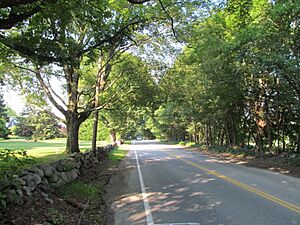Old Connecticut Path facts for kids

The Old Connecticut Path was a very old trail first used by Native Americans. It stretched from the area of Massachusetts Bay all the way west to the Connecticut River Valley. This was one of the first trails that led from the early European settlements on the Atlantic coast into the deeper parts of North America. The first colonists of the Massachusetts Bay Colony also used this path. They made it wider by driving their cattle along it. Today, parts of the old route are still followed by modern roads like Massachusetts Route 9 and Massachusetts Route 126.
Contents
History of the Old Connecticut Path
How the Path Began
In the early 1630s, the Massachusetts Bay Colony sometimes didn't have enough grain. Nipmuck farmers, who lived in the Connecticut River Valley, had plenty of corn. They would carry their extra corn in special backpacks made of birch bark. Then, they would walk along a familiar route to the settlements near the Charles River. There, they traded their food for European goods like copper, iron, and wool cloth.
Early Explorers and Settlers
Fur traders and explorers were among the first Europeans to use this trail. In 1633, a group led by John Oldham traveled along it. In 1635, some settlers from Watertown used this path when they moved to Wethersfield, Connecticut.
Thomas Hooker's Journey
A very important journey happened in 1636. Thomas Hooker, a religious leader, and about a hundred people from his church followed the Old Connecticut Path. They also brought 160 cattle with them, drinking the milk along the way. Their journey took two weeks to reach the Connecticut River. There, they settled in a place the native Lenape people called Suckiaug. This name meant "black earth." The settlers then founded the English town of Hartford.
The Path Becomes Official
By 1643, official papers in the village of Sudbury were calling this trail the "Old Connecticut Path." Later, in 1672, a postal system was set up. The Old Connecticut Path became the first colonial post road, which was a route used to deliver mail.
The Path's Route
Finding the Easiest Way
Native Americans had used this path for a very long time. They chose the easiest route, avoiding wet areas near rivers. They also found the best places to cross streams, called fords. During the trip to Connecticut, the Path crossed the Blackstone River at a place known as the North Bridge. It also crossed the Quinebaug River at a place called the South Bridge. The towns of Northbridge and Southbridge were named after these important crossing points.
Through Massachusetts
The Path started west along the north side of the Charles River from New Town (Cambridge) to Watertown. It went through what are now Waltham and Weston. Then, it curved south into the southeastern part of the new town of Sudbury. This area is now called Wayland, and a part of the route there is still named "Old Connecticut Path."
In Wayland, another path called the Bay Path (later the Boston Post Road) split off. It went west through Marlborough, Worcester, and Brookfield directly towards the Connecticut River.
In Sudbury, the Connecticut Path was known as "the road from Watertown to the Dunster Farm." It crossed the Sudbury River at a place called "Danforth's Farm," which became Framingham in 1700. Another part of the path in Framingham (Route 126) still keeps the name "Old Connecticut Path." From Framingham, the path continued south through South Framingham, Ashland, Hopkinton, Westborough, and over Fay Mountain. It then went to the praying town of Grafton (Hassanamesit/Hassanamisco), through Sutton, and then into Connecticut.
Into Connecticut
The Old Connecticut Path entered Connecticut at the praying town of Maanexit (Thompson, Connecticut) and then Woodstock. Beyond Woodstock, the path crossed Eastford, Ashford, and Willington. Today, people can walk along parts of the path in these towns, for example, on the Nipmuck Trail and in the Ruby-Fenton Recreation area. Continuing west, the trail crossed Tolland, Vernon, and a small part of Manchester before finally ending at the Connecticut River.

